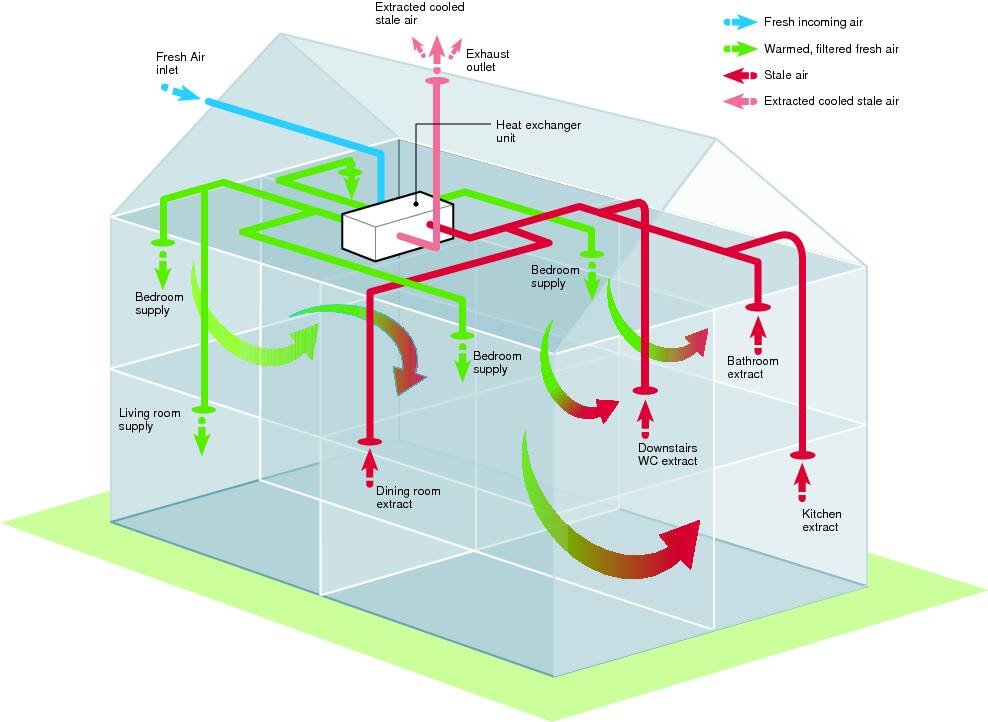MVHR explained
This article focuses on one of the most important mechanical service systems in a Passivhaus building, the Mechanical Ventilation with Heat Recovery (MVHR) System. In designing to the Passivhaus standard, it is important to understand how MVHR works, what it requires, what it does and also what it does not do. MVHR executed correctly, is key to delivering the benefits that the Passivhaus Standard promises; a comfortable, healthy, energy efficient building.
What is MVHR?
Simply speaking an MVHR system does two things. It provides Mechanical Ventilation and Recovers Heat. Fresh air is supplied to the habitable rooms of the building via a network of ducts and stale air is extracted by a separate system of fans and ducts. The supply and extract systems are separate. Heat recovery uses a heat exchanger to remove heat from warm air and transfer it to cold air. Warm air is extracted from rooms, typically the kitchen and bathrooms, then passed over the heat exchanger where the heat is removed, before being expelled to outside. The harvested heat energy is then transferred to the cold supply air by the heat exchanger and delivered to the habitable rooms such as the living room and bedrooms. Thus, expensive heat energy is retained within the building leading to high level of energy efficiency. Conventional mechanical ventilation systems, such as the one in your bathroom or kitchen, simply remove the warm air and dump it outside, wasting valuable heat.
An MVHR system is optimised when it is balanced; the amount of air coming into the building is equal to that leaving the building. This gives control over air movement maximising the amount of heat that can be recovered and reused. To achieve this the building must be Airtight. Air leakage and infiltration must be minimised. In this way building standards are far higher in a Passivhaus Building. Refer to our article on Airtightness for more detailed information. The greater control achieved by MVHR and Airtightness enables a more comfortable internal environment to be achieved and maintained for the end user.
What is required in an MVHR system?
Every MVHR system typically has the following key features;
Two grilles on the external façade, suitable spaced apart. One for fresh supply air and one for stale exhaust air.
Coupled to these grilles are two lengths of duct connected to the main MVHR unit. It is important to keep these as short as possible as they are both full of cold air. As such they should be suitable insulated with vapour permeable insulation to prevent condensation forming. The ducts also need to be airtight as they interface with the thermal envelope and airtight layer of the building.
MVHR unit itself. Inside the unit the fresh incoming air passes through a filter to remove debris and pollutants before passing over the counterflow heat exchanger, where heat harvested from the exhaust air is transferred. Both the supply and extract air streams have small in line fans to maintain air movement.
On the other side of the unit are two further ducts. One goes to all habitable rooms in the building. This is the duct supplying warm fresh air to the building. Often a small in line heating coil can be installed to assist with bringing the air up to temperature. The other 'extract' duct brings stale warm air 'back' to the unit from rooms where air is extracted. These rooms are typically kitchens, utility rooms and bathrooms. This air passes through a filter before entering the unit to remove airborne dust and debris before entering the heat exchanger.
Both of these ducts will have silencers on them to remove any noise associated with the continuously running fans. It is worth noting that the Passivhaus Standard demands that such systems run 'almost silently'.
If a duct passes between different rooms, it is good practice to fit a cross-talk silencer to ensure that noise is not transferred between rooms through the duct.
Whilst the system is very simple, it is recommended to have a qualified person design and coordinate the system for you. The system must be balanced and ducts sized accordingly to operate optimally. Equally, there is a significant interface with other systems within the building that requires detailed organisation. It is essential that the MVHR system is designed and integrated at an early stage in the design process.
What MVHR Does Not Do
It is important to note a number of things that MVHR does not do. Firstly it is not air conditioning. It does not provide cooling, although this can be added to the system if required. Secondly, it does not recirculate air, it always supplies fresh filtered air. Stale air is always expelled from the building following removal of its heat energy. Thirdly, it does not supply 'unhealthy' outdoor air as all air is filtered. Lastly, it does not extract air directly from kitchen cooker hoods. It is always recommended to install a recirculation cooker hood with grease filter that is not connected to the MVHR system. This protects the MVHR system from grease laden air entering the heat exchanger and blocking it.
What MVHR Does Do
An optimised MVHR system will do the following;
Provide controlled constant fresh air to the building improving health and well being.
Filter incoming air from pollutants, particulates and pollen, improving health and well being.
Reduces energy bills by removing waste heat from stale air and reusing it to warm incoming fresh air, reducing the heat load on the building.
Be highly energy efficient, using less energy to power the fans than it saves in harvesting waste heat energy.
Removes moisture and excess humidity from warm stale air, preventing condensation and mould, improving health and protecting the fabric of the building.
Removes indoor pollutants from the air reducing CO2, VOCs improving health, well being and improving sleep.
Installing MVHR in your home will provide you with thermal comfort, energy efficiency and control over the quality of air you breathe. It ensures that healthy comfortable ventilation is provided consistently to the rooms where it is required. It also protects the integrity of your building from the damaging effects of moisture laden air and condensation. Lastly, it provides a context for control of your internal environment. You can open windows when you want, but more importantly, you can keep them closed and still enjoy adequate ventilation and thermal comfort.
If you have found the above article useful and would like to understand more about the Passivhaus Standard, MVHR or more, we would encourage you to read the other articles in our blog available at www.novo-design.co.uk/blog. Alternatively you can join our mailing list below.



